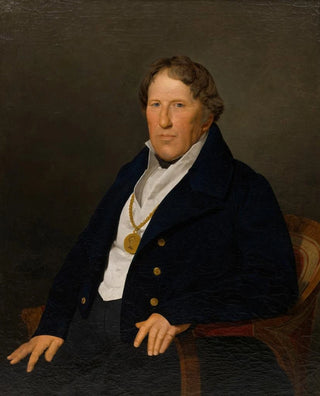Art print | Captain of the ship Mathias Feldmüller - Ferdinand Georg Waldmüller


View from behind

Frame (optional)
In the fascinating universe of art history, some artworks stand out for their ability to capture the very essence of humanity. "The Ship's Captain Mathias Feldmüller" by Ferdinand Georg Waldmüller is one of those creations that transcends time and space. This painting, created in the 19th century, immerses us in a world where human emotions, marine landscapes, and life stories intertwine with such harmony that it evokes deep admiration. The depiction of Mathias Feldmüller, a fearless captain, not only evokes the bravery of a man but also the challenges and aspirations of a rapidly changing era. Through this artwork, Waldmüller manages to establish a powerful emotional connection between the viewer and the subject, making the artistic experience unforgettable.
Style and uniqueness of the work
Waldmüller's style is characterized by striking realism, where every detail is carefully observed and rendered with remarkable precision. In "The Ship's Captain Mathias Feldmüller," the artist uses a palette of rich and vibrant colors that evoke natural light, creating an atmosphere that is both lively and melancholic. The facial features of the captain, imbued with dignity and determination, are accentuated by plays of shadow and light that reveal the depth of his character. The composition of the work, with its maritime background and subtle narrative elements, invites the viewer to immerse themselves in the story of the character. Waldmüller succeeds in transcending mere representation to offer a true visual and emotional experience, making this work an emblematic example of 19th-century realism.
The artist and his influence
Ferdinand Georg Waldmüller, an emblematic figure of Austrian art, knew how to mark his era with his innovative approach and commitment to realism. Born in 1793, he was influenced by the sociopolitical upheavals of his time, which is reflected in his works. Waldmüller dedicated himself to capturing everyday life, portraits, and scenes of

Matte finish

View from behind

Frame (optional)
In the fascinating universe of art history, some artworks stand out for their ability to capture the very essence of humanity. "The Ship's Captain Mathias Feldmüller" by Ferdinand Georg Waldmüller is one of those creations that transcends time and space. This painting, created in the 19th century, immerses us in a world where human emotions, marine landscapes, and life stories intertwine with such harmony that it evokes deep admiration. The depiction of Mathias Feldmüller, a fearless captain, not only evokes the bravery of a man but also the challenges and aspirations of a rapidly changing era. Through this artwork, Waldmüller manages to establish a powerful emotional connection between the viewer and the subject, making the artistic experience unforgettable.
Style and uniqueness of the work
Waldmüller's style is characterized by striking realism, where every detail is carefully observed and rendered with remarkable precision. In "The Ship's Captain Mathias Feldmüller," the artist uses a palette of rich and vibrant colors that evoke natural light, creating an atmosphere that is both lively and melancholic. The facial features of the captain, imbued with dignity and determination, are accentuated by plays of shadow and light that reveal the depth of his character. The composition of the work, with its maritime background and subtle narrative elements, invites the viewer to immerse themselves in the story of the character. Waldmüller succeeds in transcending mere representation to offer a true visual and emotional experience, making this work an emblematic example of 19th-century realism.
The artist and his influence
Ferdinand Georg Waldmüller, an emblematic figure of Austrian art, knew how to mark his era with his innovative approach and commitment to realism. Born in 1793, he was influenced by the sociopolitical upheavals of his time, which is reflected in his works. Waldmüller dedicated himself to capturing everyday life, portraits, and scenes of






